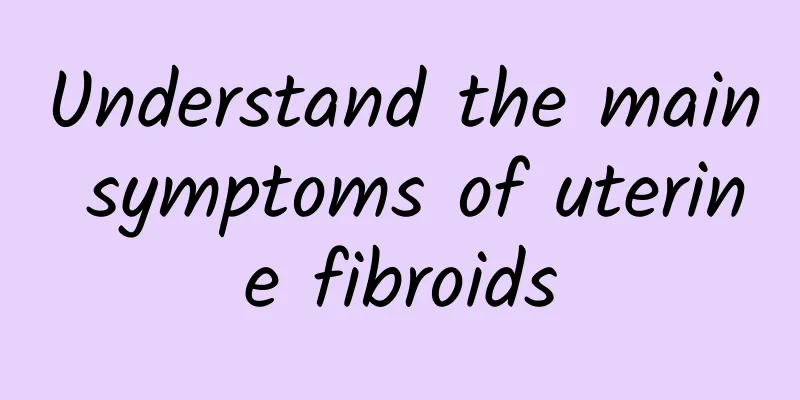Understand the main symptoms of uterine fibroids

|
Do you know what the symptoms of uterine fibroids are? What do the symptoms of uterine fibroids look like? When we don't know the symptoms of uterine fibroids, we often think that we are just experiencing common gynecological symptoms, but we don't know that a potential female killer is quietly approaching you... If you want to know more about the symptoms of uterine fibroids, please pay attention to the following introductions to the symptoms of uterine fibroids compiled by experts: 1. Increased leucorrhea: Increased leucorrhea, sometimes with a large amount of purulent and bloody discharge and slough-like tissue discharge with a foul odor. This is a common gynecological symptom and also an early manifestation of uterine fibroids. 2. Menstrual changes: The most common symptom of uterine fibroids, manifested as shortened menstrual cycle, increased menstrual flow, prolonged menstrual period, irregular vaginal bleeding, etc. 3. Pain: Generally, patients do not have abdominal pain, but often have lower abdominal distension, back pain, etc. 4. Abdominal mass: The abdomen is swollen, and a mass can be felt in the lower abdomen, accompanied by a feeling of falling. When the pedicle of the subserosal fibroid is twisted, acute abdominal pain may occur. When the fibroid turns red, the abdominal pain is severe and accompanied by fever. 5. Infertility: Fibroids compress the fallopian tubes, causing them to twist, or deform the uterine cavity, thus preventing the fertilized egg from implanting and leading to infertility. 6. Secondary anemia: If the patient has excessive menstruation for a long time, it may lead to secondary anemia, with symptoms such as general fatigue, pale complexion, shortness of breath, and palpitations. 7. Hypoglycemia: Hypoglycemia associated with uterine fibroids is also rare. The main symptoms are low fasting blood sugar, loss of consciousness and even shock. The symptoms can completely disappear after glucose injection. The symptoms of hypoglycemia will completely disappear after tumor resection. 8. Compression symptoms: When the fibroids grow forward or backward, they can compress the bladder, urethra or rectum, causing frequent urination, dysuria, urinary retention or constipation. When the fibroids grow to both sides, they form broad ligament fibroids, which can compress the ureter and cause hydroureteral or renal pelvis; if they compress the pelvic blood vessels and lymphatic vessels, they can cause lower limb edema, which is a symptom of uterine fibroids that only exists in the late stage. The symptoms of uterine fibroids are very obvious. When symptoms of uterine fibroids appear, you must consult the hospital in time to ensure that the uterine fibroids are cured in the early stage and will not cause greater consequences to us. If you still have doubts about the symptoms of uterine fibroids, please consult our online experts, who will answer your questions. I wish you health and beauty! Uterine fibroids http://www..com.cn/fuke/zgjl/ |
<<: Do you know what ovarian cysts are?
>>: What are the main groups of people who suffer from uterine fibroids?
Recommend
Can infertility caused by endometriosis be cured?
Can infertility caused by endometriosis be treate...
Will untreated pelvic inflammatory disease lead to ectopic pregnancy?
Will untreated pelvic inflammatory disease cause ...
Causes of cervicitis in women
Cervicitis is a disease that occurs in the cervix...
What are the symptoms of spontaneous abortion?
Spontaneous abortion may cause symptoms such as v...
What Chinese medicine is used to treat pelvic inflammatory disease
What Chinese medicine is used to treat pelvic inf...
What kind of surgery can be done for large uterine fibroids? ...
Uterine fibroids are one of the most common gynec...
What should I do if I suffer from uterine fibroids? What are the symptoms of uterine fibroids?
With the development of society and the improveme...
What are the examination items for pelvic peritonitis?
Core Tip: Female pelvic genital inflammation is o...
What to do for Bartholinitis
The vestibular glands are located on both sides o...
Endometrial tuberculosis treatment price
In modern life, with busy work, irregular life an...
My period came a few days earlier than usual. What should I do?
My period came a few days earlier than usual. Wha...
What foods can thicken the uterine lining?
Endometrial thickening is second only to cervical...
The causes of cervicitis that everyone needs to know
Cervicitis is a gynecological disease that harms ...
What are the principles of medication in the treatment of Bartholinitis?
The main pathogens of Bartholinitis are Staphyloc...
Will uterine fibroids affect pregnancy? Is surgery necessary if uterine fibroids are detected before pregnancy?
Uterine fibroids are a common disease in women ov...









